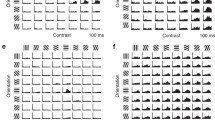Abstract
A family of moving ‘random-line’ patterns was developed and used to study the directional tuning of 91 single units in cat primary visual cortex (V1). The results suggest that, in addition to the well-known orientation-dependent mechanism, there is also some kind of orientationindependent mechanism underlying the direction selectivity. The directional tuning of the neurons varies in accordance with the increase of orientation or non-orientation element in the stimulus.
Similar content being viewed by others
References
Movshon, J. A., Adelson, E. H., Gizzi, M. S. et al., The analysis of moving visual patterns, in Pattern Recognition Mechanisms (eds. Chagas, C., Gattass, R., Gross, C. G.), Vatican City: Ponticifica Academia Scientiarum, 1985, 117–151.
Gizzi, M. S., Katz, E., Schumer, R. A. et al., Selectivity for orientation and direction of motion of single neurons in cat striate and extrastriate visual cortex, J. Neurophysiol., 1990, 63: 1529–1543.
Nakayama, K., Silverman, G.H., The aperture problem. II. Spatial integration of velocity information along contours, Vision Res., 1988, 28: 747–753.
Rubin, N., Hochstein, S., Solomon, S., Restricted ability to recover three-dimensional global motion from one-dimensional motion signals: Psychophysical observations, Vision Res., 1995, 35: 463–476.
Wang, Y., Wang, L., Li, B. et al., How is direction selectivity organized in the extrastriate visual area PMLS of the cat? Neuroreport, 1995, 63: 1969–1974.
Li, B., Wang, L., Wang, Y. et al., Orientational and directional selectivities of visual neurons in the superior colliculus of the cat, Science in China, Ser. C, 1996, 39 (2): 123–132.
Hubel, D. H., Wiesel, T. N., Receptive fields, binocular interaction and functional architecture in the cat’s visual cortex, J. Physiol. (London), 1962, 168: 106–154.
Casanova, C., Savard, T., Nordmann, J. P. et al., Comparison of the responses to moving texture patterns of simple and complex cells in the cat’s area 17, J. Neurophysiol., 1995, 74: 1271–1286.
Yang, J. K., Qi, X. L., Modern Biological Statistics (in Chinese), Hefei: Anhui Educational Publication, 1985, 160–215.
Shipp, S., Grant, S., Organization of reciprocal connections between area 17 and the lateral suprasylvian area of cat visual cortex, Visual Neurosci., 1991, 6: 339–355.
Albright, T. D., Stoner, G.R., Visual motion perception, Proc. Natl. Acad. Sci. USA, 1995, 92: 2433–2440.
Hammond, P., MacKay, D. M., Differential responsiveness of simple and complex cells in cat striate cortex to visual texture, Exp. Brain Res., 1977, 30: 275–296.
Wörgötter, F., Gründel, O., Eysel, U. T., Quantification and comparison of cell properties in cat’s striate cortex determined by different types of stimuli, Eur. J. Neurosci., 1990, 2: 928–941.
Skottun, B. C., Zhang, J., Grosof, D. H., On the direction selectivity of cells in the visual cortex to drifting dot patterns, Visual Neurosci., 1994, 11: 885–897.
Ferrera, V.P., Wilson, H. R., Perceived direction of moving two-dimensional patterns, Vision Res., 1990, 30: 273–287.
Henry, G.H., Bishop, P. O., Dreher, B., Orientation, axis and direction as stimulus parameters for striate cells, Vision Res., 1974, 14: 767–777.
Lorenceau, J., Shiffrar, M., Wells, N. et al., Different motion sensitive units are involved in recovering the direction of moving lines, Vision Res., 1993, 33: 1207–1217.
Sillito, A. M., Grieve, K. L., Jones, H. E. et al., Visual cortical mechanisms detecting focal orientation discontinuities, Nature, 1995, 378: 492–496.
Shevelev, I. A., Lazareva, N. A., Sharaev, G.A. et al., Selective and invariant sensitivity to crosses and corners in cat striate cortex neurons, Neuroscience, 1998, 84: 713–721.
Author information
Authors and Affiliations
Corresponding author
Rights and permissions
About this article
Cite this article
Chen, Y., Li, B., Li, B. et al. Directional tunings independent of orientation in the primary visual cortex of the cat. Sci. China Ser. C.-Life Sci. 44, 513–523 (2001). https://doi.org/10.1007/BF02882394
Received:
Issue Date:
DOI: https://doi.org/10.1007/BF02882394




